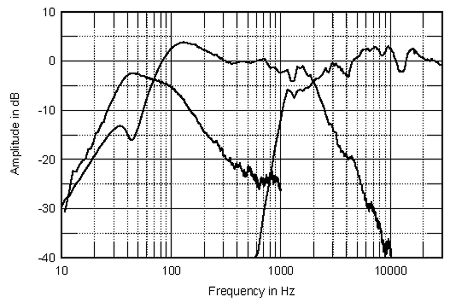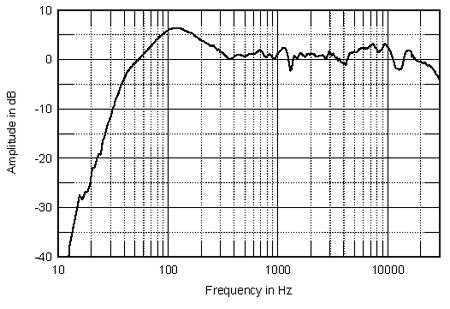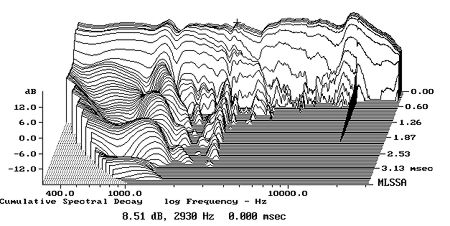| Columns Retired Columns & Blogs |
Wharfedale Diamond 9.1 loudspeaker Measurements
Sidebar 3: Measurements
As might be expected from its small size, the Diamond 9.1 is of below-average voltage sensitivity, at an estimated 85.5dB(B)/2.83V/m. However, its impedance plot (fig.1), other than a dip to 3.9 ohms in the lower midrange and a combination of 5.7 ohms impedance and –36° capacitive phase angle at 120Hz, indicates that the speaker should be fairly easy to drive.

Fig.1 Wharfedale Diamond 9.1, electrical impedance (solid) and phase (dashed). (2 ohms/vertical div.)
Some very slight wrinkles in the impedance traces between 150Hz and 900Hz imply the existence of some cabinet resonances. Investigating the panels' vibrational behavior with a plastic-tape accelerometer revealed a strong resonant mode present on all surfaces, but strongest on the sidewall (fig.2). Other modes existed at 465Hz and 900Hz but were not as strong. This mode is a little high in frequency to contribute to the "warmth" BJR noted in his auditioning; though it might add some midrange congestion with some kinds of music, Bob Reina didn't hear anything untoward in this respect.

Fig.2 Wharfedale Diamond 9.1, cumulative spectral-decay plot calculated from the output of an accelerometer fastened to the center of the cabinet's side panel (MLS driving voltage to speaker, 7.55V; measurement bandwidth, 2kHz).
The impedance plot indicates that the small woofer's reflex loading is tuned to 50Hz. However, as can be seen in fig.3, the expected notch in its response actually occurs a little lower in frequency, at 45Hz, with the twin ports covering a wide bandpass from 30Hz to 120Hz. (The outputs of the woofer and ports in this graph are scaled in the ratio of the square roots of their radiating areas.) The ports' higher-frequency rollout is free from the spikes that would indicate the presence of resonances, while the woofer crosses over to the tweeter at approximately 2kHz, with some overlap apparent. Both drivers mainly have relatively flat outputs within their respective passbands, with peaks balanced by dips.

Fig.3 Wharfedale Diamond 9.1, acoustic crossover on tweeter axis at 50", corrected for microphone response, with nearfield responses of woofer and port, plotted below 300Hz and 1kHz, respectively.
The exception is the woofer, whose response peaks by 4dB or so in the upper bass. This is partially due to the nearfield measurement technique, but when you look at the combined output of the woofer and port, plotted below 300Hz in fig.4, there is still too much upper-bass energy apparent. This, the "LS3/5a British upper-bass bump trick," is most likely the cause of the character noted by BJR in his auditioning comments. The Diamond 9.1 is otherwise impressively flat, though the small peak and dip noticeable between 1 and 2kHz might add a touch of nasality. But note the impressive HF extension offered by the tweeter, with no hint below 30kHz of its ultrasonic dome resonance. I am not surprised BJR was so impressed by the Diamond's treble.

Fig.4 Wharfedale Diamond 9.1, anechoic response on tweeter axis at 50", averaged across 30° horizontal window and corrected for microphone response, with the complex sum of the nearfield woofer and port responses, taking into account acoustic phase and distance from the nominal farfield point, plotted below 300Hz.
A speaker may offer a flat on-axis response, but how that response changes to the speaker's sides also affects its perceived tonal balance. Here the little Wharfedale also performed well, with a wide, even lateral dispersion below 8kHz or so (fig.5). What appears to be a slight flare at the bottom of the tweeter's passband in this graph is actually the small notch at 4kHz in the on-axis response filling in to the speaker's sides. In the vertical plane (fig.6), the overlap in the crossover region between the two drive-units leads to a peak developing in the low treble more than 10° above the tweeter axis, and a corresponding notch more than 10° below that axis. Suitable stands should be used to place the Diamond 9.1s' tweeters at ear level.

Fig.5 Wharfedale Diamond 9.1, lateral response family at 50", normalized to response on tweeter axis, from back to front: differences in response 90–5° off axis, reference response, differences in response 5–90° off axis.

Fig.6 Wharfedale Diamond 9.1, vertical response family at 50", normalized to response on tweeter axis, from back to front: differences in response 45–5° above axis, reference response, differences in response 5–45° below axis.
In the time domain, the Wharfedale's step response (fig.7) indicates that both drive-units are connected in positive acoustic polarity. A slight ripple can be seen in the tail of the woofer's step, which, as the speaker's waterfall plot shows (fig.8), is associated with two resonant modes: one at 2930Hz, and one that correlates with the peak between 1 and 2kHz on which I commented earlier. Otherwise, this plot is extremely clean in the treble, again supporting BJR's comments about the Diamond 9.1's excellent tweeter.

Fig.7 Wharfedale Diamond 9.1, step response on tweeter axis at 50" (5ms time window, 30kHz bandwidth).

Fig.8 Wharfedale Diamond 9.1, cumulative spectral-decay plot at 50" (0.15ms risetime).
Considering it costs just $350/pair, Wharfedale's Diamond 9.1 offers superb measured performance. In that respect, it is streets ahead of its ancestor, the similar-sized Diamond IV (reviewed in the July 1991 Stereophile), which cost $400/pair, didn't measure as well, and sounded more colored in the upper midband.—John Atkinson
- Log in or register to post comments




































